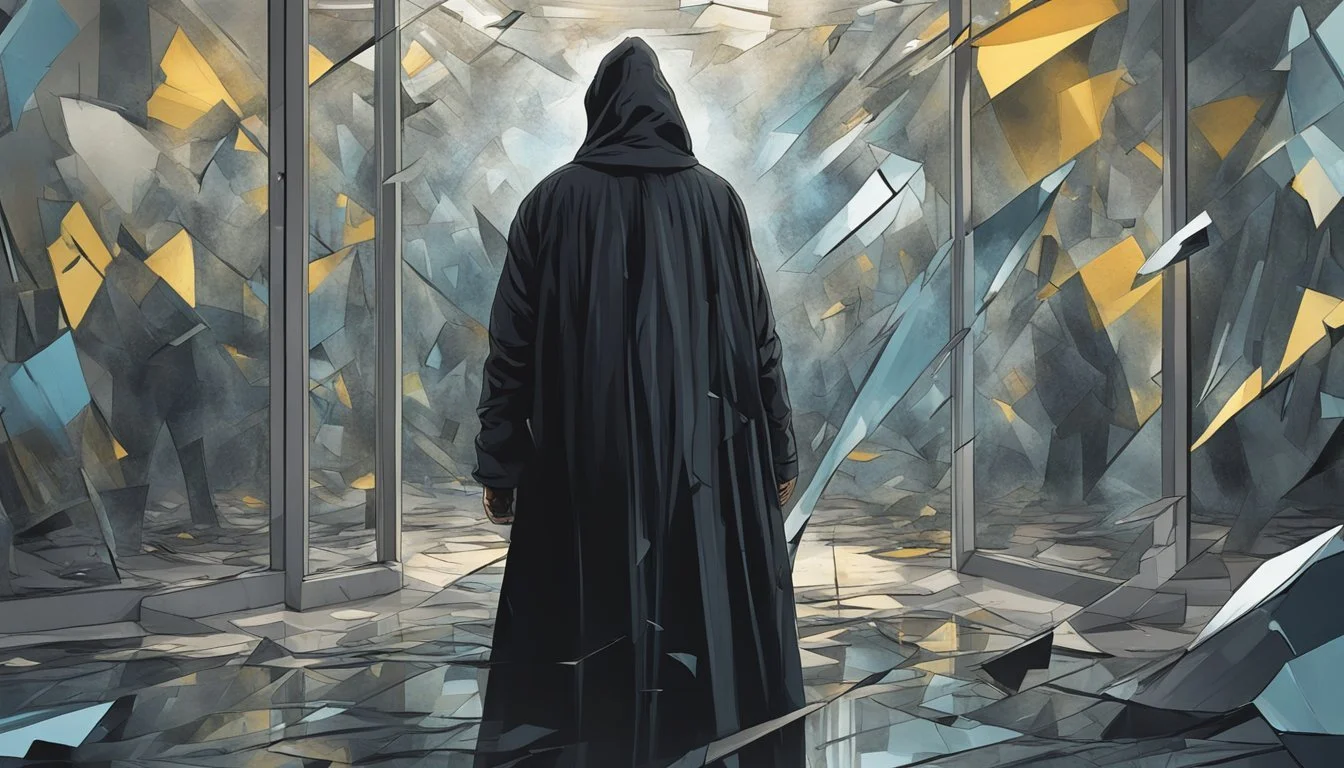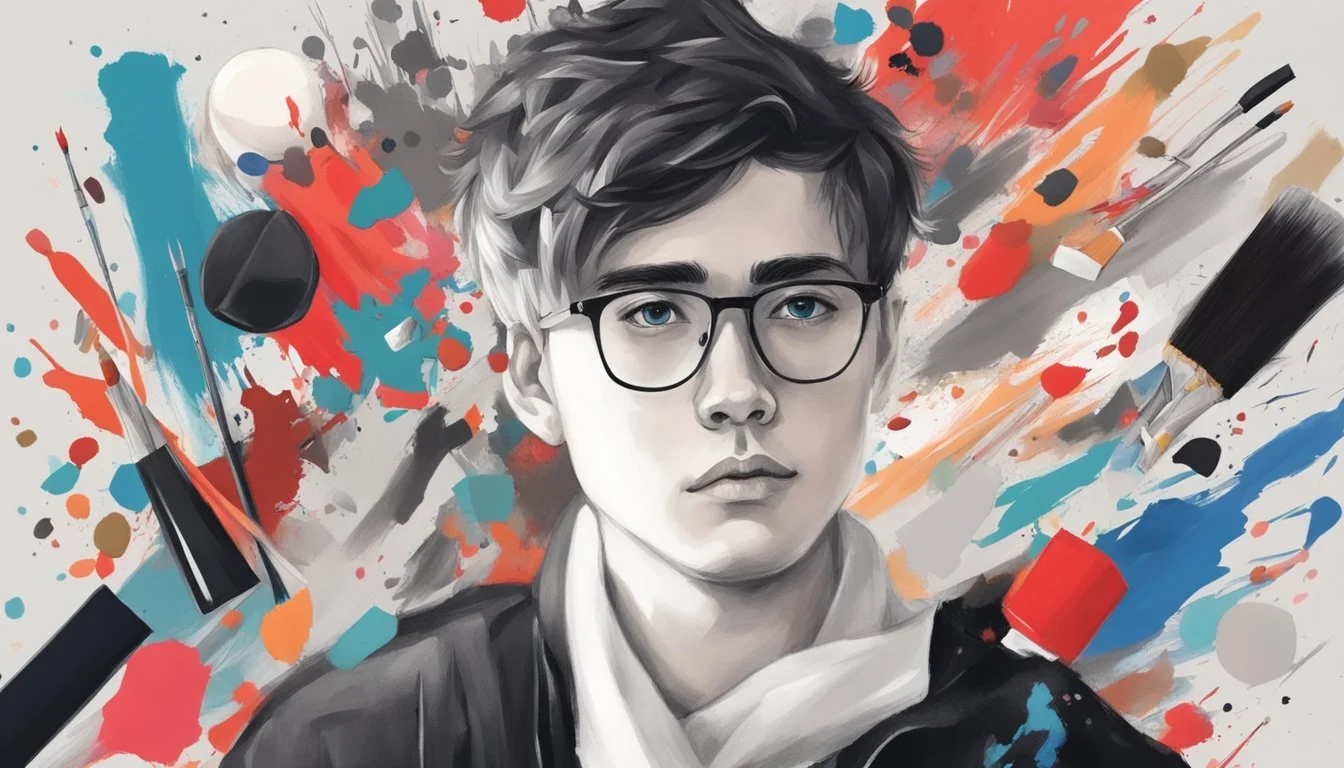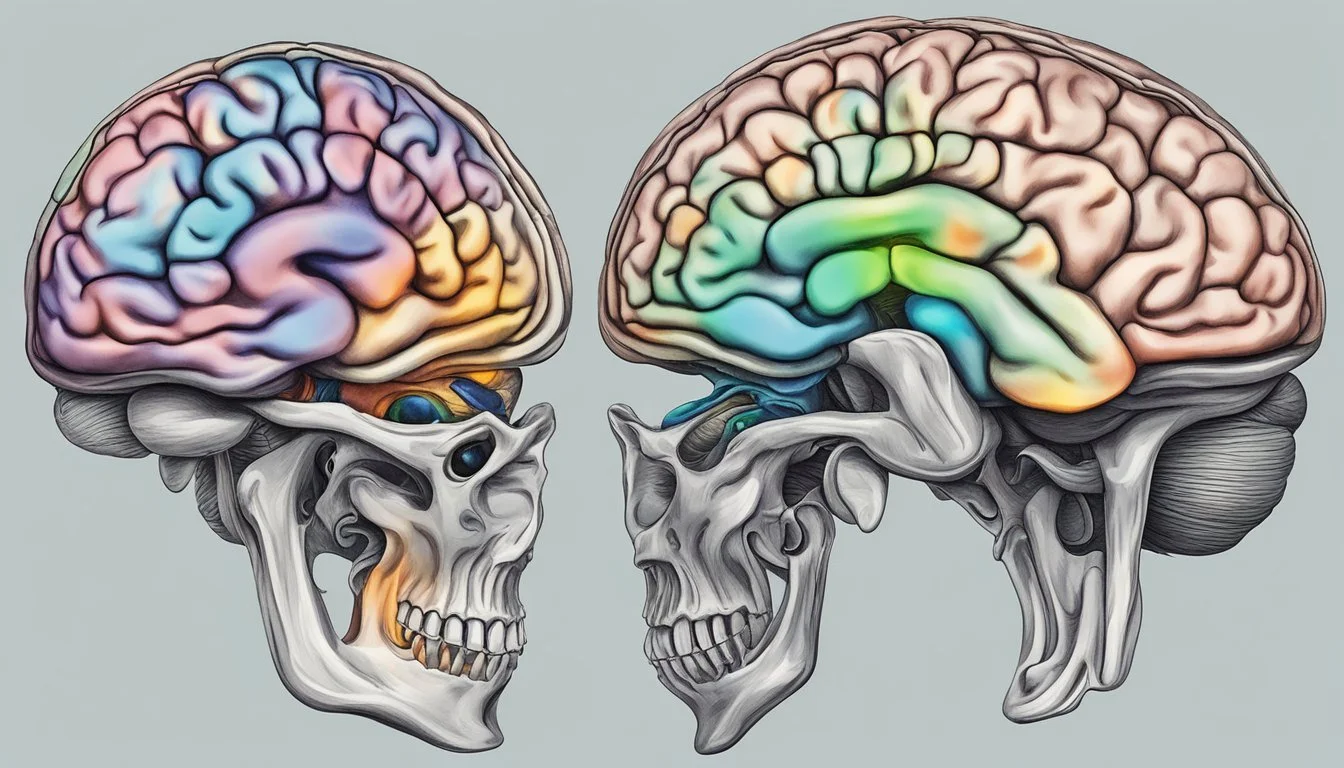Psychopath Art: Exploring the Dark Creativity of Disturbed Minds
Psychopath art offers a unique window into the minds of individuals with antisocial personality traits. This controversial genre encompasses works created by artists who may possess psychopathic characteristics, as well as pieces that explore themes related to psychopathy. Recent studies suggest that certain psychopathic traits, such as fearlessness and emotional detachment, might actually enhance creative abilities in some artists.
The intersection of art and psychopathy raises intriguing questions about the nature of creativity and mental health. While not all artists exhibit psychopathic tendencies, those who do may channel their unconventional perspectives into compelling and provocative works. This blend of talent and personality traits can result in art that challenges societal norms and pushes artistic boundaries.
Psychopath art spans various mediums, from paintings and sculptures to digital creations and performance pieces. Many artists working in this realm explore themes of isolation, power dynamics, and altered perceptions of reality. These works often evoke strong emotional responses in viewers, sparking conversations about the complex relationship between mental states and artistic expression.
Exploring Psychopathic Traits in Artists
Recent studies have uncovered intriguing connections between artistic creativity and certain psychopathic traits. This overlap challenges common perceptions and sheds light on the complex nature of artistic genius.
Defining Psychopathy and Its Dimensions
Psychopathy is characterized by a cluster of personality traits including boldness, disinhibition, and meanness. Boldness encompasses fearlessness and social dominance. Disinhibition involves impulsivity and poor behavioral controls. Meanness relates to callousness and lack of empathy.
These traits exist on a spectrum, with clinical psychopathy at the extreme end. In milder forms, some of these characteristics may contribute to creative thinking and artistic expression.
Researchers have identified subclinical psychopathic traits in the general population. These include charm, confidence, risk-taking, and emotional detachment. Such qualities, when balanced, can potentially enhance creative output.
Psychopathy in the Art World
The art world often rewards traits associated with psychopathy. Risk-taking and boldness can lead to innovative artistic choices. Emotional disinhibition may allow artists to explore taboo subjects or unconventional techniques.
Some artists leverage their charisma and persuasiveness to promote their work. These qualities align with the charm often seen in individuals with psychopathic traits.
The intense focus and detachment exhibited by some artists echo psychopathic tendencies. This emotional distance can facilitate objective self-criticism and persistence in the face of rejection.
However, it's crucial to note that most artists do not exhibit clinical psychopathy. The presence of some psychopathic traits does not equate to a disorder.
Profiles of Artists with Psychopathic Traits
Historical and contemporary artists have displayed behaviors consistent with psychopathic traits. Salvador Dali's eccentric public persona and provocative art exemplify boldness and disinhibition.
Caravaggio, known for his revolutionary paintings, led a tumultuous life marked by violence and risk-taking. His behavior aligns with psychopathic tendencies, yet his art remains highly influential.
More recently, figures like Damien Hirst have courted controversy through provocative works. Hirst's willingness to challenge norms and his business acumen reflect traits associated with psychopathy.
It's important to approach these profiles with nuance. While certain traits may contribute to artistic success, they don't define the entirety of an artist's personality or work.
The Intersection of Creativity and Psychopathy
The relationship between creative genius and psychopathic traits has long fascinated researchers and the public alike. Studies have explored potential links between artistic brilliance and certain personality characteristics associated with psychopathy.
Studies on Creativity and Psychopathic Traits
Research has identified connections between creative achievement and specific psychopathic traits. A model of psychopathy includes three key components: boldness, meanness, and disinhibition.
Creative individuals often exhibit boldness through reduced fear responses and stress resilience. This fearlessness may enable them to take risks and pursue innovative ideas.
Some studies have found higher rates of psychopathic traits among artists and scientists compared to the general population. However, results vary based on the type of creativity and specific psychopathic characteristics examined.
Creative Personalities and Psychological Profiles
Creative personalities frequently display traits that overlap with psychopathic tendencies. These may include:
High self-confidence
Willingness to break rules and challenge norms
Emotional detachment or reduced empathy
Impulsivity and sensation-seeking
Not all creative individuals exhibit these qualities, and those who do may experience them to varying degrees. Creative genius does not inherently require or indicate psychopathology.
The Dark Triad: Narcissism, Machiavellianism, and Psychopathy
The Dark Triad refers to three interrelated personality traits: narcissism, Machiavellianism, and psychopathy. Research has explored how these traits may manifest in creative personalities.
Narcissism can fuel creative ambition and self-promotion. Machiavellianism may aid in strategic career advancement. Psychopathic traits like fearlessness and charisma can enhance creative risk-taking and persuasion.
While Dark Triad traits may offer some benefits for creative pursuits, they can also lead to interpersonal difficulties and ethical concerns. The relationship between creativity and these traits remains complex and nuanced.
Artistic Output and Psychopathic Boldness
Psychopathic traits like boldness and emotional disinhibition may contribute to artistic creativity and risk-taking in the creative process. These characteristics can lead artists to push boundaries and create novel works.
Risk-Taking and Novelty in Art
Artists with psychopathic boldness tend to take greater risks in their creative endeavors. They often challenge established norms and explore unconventional ideas without fear of criticism. This fearlessness can result in groundbreaking artworks that redefine genres or create entirely new artistic movements.
Examples include:
Pablo Picasso's cubism
Jackson Pollock's abstract expressionism
Marina Abramović's provocative performance art
These artists pushed the limits of their respective mediums, disregarding potential backlash or failure. Their willingness to take artistic risks often led to innovative and influential works.
Influence of Emotional Disinhibition on Art
Emotional disinhibition, a trait associated with psychopathy, can significantly impact artistic output. Artists with this characteristic may:
Express raw emotions more freely in their work
Tackle taboo subjects without hesitation
Create confrontational or shocking pieces
This uninhibited approach can result in powerful, evocative art that resonates deeply with audiences. It allows artists to explore the full spectrum of human experience, including darker or more controversial themes.
Some artists harness emotional disinhibition to:
Convey intense feelings through their chosen medium
Challenge societal norms and expectations
Provoke strong reactions from viewers or listeners
Perception of Psychopaths in Art
The portrayal and reception of psychopathic artists in society is complex, often marred by misconceptions. Artistic expression can both reinforce and challenge stereotypes about psychopathy, shaping public understanding in nuanced ways.
Society's View of Psychopathic Artists
Many people associate psychopathy with violence and manipulation, leading to negative perceptions of artists labeled as psychopaths. Media portrayals often sensationalize psychopathic traits, reinforcing stereotypes. Some view psychopathic artists as dangerous or unpredictable.
However, research suggests psychopathy exists on a spectrum. Not all individuals with psychopathic traits engage in harmful behavior. In the art world, traits like boldness and disinhibition may fuel creativity and risk-taking.
Public fascination with psychopathic artists sometimes leads to increased attention and sales. This can create a problematic dynamic where negative behavior is inadvertently rewarded or glorified through commercial success.
Challenging Stereotypes through Artistic Expression
Art offers a unique platform for exploring and reframing perceptions of psychopathy. Some artists with psychopathic traits use their work to challenge societal assumptions and provide insight into their experiences.
Through visual art, literature, and performance, these creators can:
Depict the internal world of psychopathy
Highlight the diversity within the psychopathic spectrum
Explore themes of empathy and emotional processing
This artistic expression can foster understanding and empathy among viewers. It may help reduce stigma by presenting more nuanced portrayals of psychopathy.
Critics argue that romanticizing psychopathic traits in art is dangerous. They worry it could normalize harmful behaviors. Balancing honest representation with responsible messaging remains an ongoing challenge in the art world.
Psychopathy and Artistic Mediums
Psychopathic traits manifest differently across various artistic disciplines. Some mediums may attract or amplify certain psychopathic tendencies more than others.
Penchant for Certain Art Forms
Visual arts often draw individuals with psychopathic traits. Painters like Picasso exhibited bold, rule-breaking approaches characteristic of psychopathic fearlessness. Their willingness to defy conventions led to groundbreaking styles like cubism.
Performance arts can appeal to those seeking attention and admiration. The stage provides an outlet for grandiosity and manipulation of audiences' emotions.
Literature attracts psychopathic writers skilled at crafting complex characters and plots. Their reduced empathy may allow more objective portrayals of human nature.
Music composition and performance resonate with psychopathic traits like fearlessness and charisma. Rock and hip-hop genres especially celebrate rebellious, anti-social attitudes.
Architecture and Psychopathy: Structure and Aesthetics
Psychopathic architects may gravitate towards imposing, awe-inspiring designs. Their reduced empathy could result in prioritizing visual impact over human comfort.
Brutalist architecture, with its stark concrete forms, exemplifies a style potentially appealing to psychopathic sensibilities. Its raw, unadorned aesthetic aligns with psychopathic traits of coldness and lack of sentimentality.
Some psychopathic architects might excel at creating innovative, unconventional structures. Their boldness and disregard for tradition could lead to groundbreaking designs that reshape cityscapes.
However, their impulsivity and lack of concern for others' well-being might result in unsafe or impractical buildings if left unchecked.
The Role of the Environment
The environment plays a crucial role in shaping psychopathic artists and their creative expressions. Social contexts and cultural norms significantly influence the development of psychopathic traits and artistic output.
Impact of Community and Culture on Psychopathic Artists
Community groups exert a powerful influence on psychopathic individuals with artistic inclinations. The social environment can either amplify or suppress psychopathic tendencies in creative pursuits.
In some cases, tight-knit communities may inadvertently enable psychopathic behaviors by overlooking warning signs or rationalizing concerning actions. Conversely, supportive community structures can provide positive outlets for creative expression.
Cultural norms shape societal expectations around artistic expression. Certain cultures may be more accepting of provocative or transgressive art, potentially attracting psychopathic artists seeking to push boundaries.
The art world itself can form a unique subculture. Competitive and ego-driven environments may appeal to individuals with psychopathic traits, fueling their creative ambitions.
Environmental Influences on Creative Expression
Physical and social environments significantly impact the artistic output of psychopathic individuals. Chaotic or unstable living conditions may intensify psychopathic tendencies and manifest in darker, more turbulent artworks.
Exposure to violence or trauma can profoundly shape an artist's perspective and subject matter. Psychopathic artists may channel these experiences into their work, producing intense or disturbing pieces.
Access to resources and education plays a vital role in artistic development. Limited opportunities may frustrate psychopathic individuals, potentially leading to more provocative or attention-seeking art forms.
The digital age has created new avenues for artistic expression. Online platforms allow psychopathic artists to reach wider audiences and potentially find like-minded communities that reinforce their worldviews.
Understanding the Brain Function of Psychopathic Artists
Psychopathic traits and artistic creativity share intriguing neural connections. Research has uncovered similarities in brain function between psychopaths and highly creative individuals, particularly in areas related to cognition and emotional processing.
Neural Correlates of Creative Cognition
Creative cognition in psychopathic artists involves unique patterns of brain activity. The prefrontal cortex, crucial for planning and decision-making, shows heightened activation during creative tasks. This may explain the bold, unconventional thinking often associated with psychopathic artists.
Studies have found increased connectivity between brain regions responsible for divergent thinking and cognitive control in both psychopaths and creative individuals. This enhanced neural communication could facilitate the generation of novel ideas and artistic expressions.
The default mode network, linked to imagination and self-reflection, exhibits atypical functioning in psychopaths. This altered activity may contribute to their ability to detach from conventional perspectives and produce innovative artworks.
Emotion Regulation and Arousal
Psychopathic artists often display distinct patterns of emotional processing and arousal. The amygdala, central to emotion regulation, shows reduced responsiveness in psychopaths. This diminished emotional reactivity may allow them to approach artistic subjects with a detached, analytical perspective.
Brain imaging studies reveal decreased activity in empathy-related neural circuits among psychopaths. Paradoxically, this emotional disconnect might enable psychopathic artists to explore provocative or taboo themes without inhibition.
The autonomic nervous system of psychopaths exhibits lower baseline arousal levels. This understimulation could drive their pursuit of intense sensory experiences through art, potentially explaining the vivid and sometimes shocking nature of their creative outputs.
Behavioral Patterns and Art
Psychopathic traits can manifest in unique ways within artistic practices. These patterns often involve dishonesty, manipulation, and a tendency to break established norms.
Dishonesty and Manipulation in Artistic Practices
Some artists with psychopathic tendencies may engage in deceptive behaviors to gain recognition or financial gain. They might forge artworks, misrepresent their credentials, or fabricate elaborate backstories for their pieces.
These individuals may manipulate gallery owners, critics, or collectors to promote their work. They often lack empathy for those they exploit in pursuit of artistic success.
Some psychopathic artists excel at mimicking popular styles or trends without genuine emotional investment. This allows them to capitalize on market demands while maintaining emotional detachment.
Patterns of Rule-Breaking and Nonconformity
Artists with psychopathic traits frequently challenge artistic conventions and societal norms. They may deliberately provoke controversy or shock audiences to gain attention.
These individuals often disregard copyright laws, appropriating others' work without permission or credit. They might also ignore safety regulations when creating large-scale or hazardous installations.
Some psychopathic artists push ethical boundaries in their work, exploiting sensitive subjects or vulnerable individuals. They may justify these actions as artistic freedom or social commentary.
Their art can reflect a lack of anxiety about social judgment, resulting in uninhibited expression. This fearlessness sometimes leads to groundbreaking innovations in technique or subject matter.
Contemporary Research and Discussions
Recent studies have explored the intersection of psychopathy and artistic expression. Researchers are uncovering new insights into the creative processes and motivations of artists with psychopathic traits.
Latest Updates in Psychopath Art Studies
A study in Personality and Individual Differences revealed that artists, actors, and other creative professionals share certain traits with psychopaths. The research, led by Adrianne John Galang at De La Salle University in Manila, found commonalities in personality characteristics between these groups.
This finding has sparked interest in how psychopathic traits might influence artistic output. Some researchers suggest that traits like boldness and disinhibition could contribute to innovative and boundary-pushing art forms.
Art therapy has also gained attention as a potential treatment for individuals with psychosis-related diagnoses. Therapists have worked with this population for decades, exploring how creative expression can aid in mental health management.
The Role of Research in Understanding Psychopathy in Art
Research plays a crucial role in unraveling the complex relationship between psychopathy and artistic creation. Scientists are investigating the neurobiological and environmental factors that may contribute to both psychopathic tendencies and creative abilities.
Studies on dark personality traits, including psychopathy, are shedding light on their relevance to abnormal psychology. This research examines the nature, origins, and development of these traits, providing valuable insights for clinicians and art therapists.
Ongoing investigations aim to identify specific psychopathic characteristics that might enhance creativity. By understanding these connections, researchers hope to develop targeted interventions and support systems for artists with psychopathic traits.
Community and Support Systems
Artistic communities and support networks play a crucial role for psychopathic creatives. These systems provide opportunities for engagement, growth, and understanding within a structured environment.
Engagement with Artistic Community Groups
Community art groups offer psychopathic artists spaces to connect and collaborate. Local galleries, studios, and workshops host events where these individuals can showcase their work. Online forums and social media platforms create virtual communities for sharing ideas and techniques.
Art therapy groups specifically tailored for those with psychopathic traits exist in some areas. These groups focus on channeling emotions and experiences through creative expression. Participants can explore their unique perspectives in a supportive setting.
Some universities and art schools have programs that accommodate neurodiverse students, including those with psychopathic tendencies. These programs provide specialized mentorship and resources.
Support Activities for Psychopathic Creatives
Structured activities help psychopathic artists develop their skills and manage their tendencies. Art challenges and competitions offer goal-oriented opportunities for creative expression. These events can provide external motivation and deadlines.
Mentorship programs pair experienced artists with psychopathic creatives. Mentors guide skill development and offer insights into navigating the art world. They can also help mentees understand and work within professional boundaries.
Group projects and collaborative installations allow psychopathic artists to practice teamwork and communication. These activities foster a sense of shared purpose and community involvement.
Workshops on emotional intelligence and empathy through art can be beneficial. These sessions teach techniques for recognizing and expressing emotions visually, potentially improving interpersonal skills.
Profiles and Biographies
Artists with psychopathic traits have fascinated researchers and the public alike. Their unique perspectives and creative outputs offer intriguing insights into the intersection of art and psychology.
Case Studies of Noteworthy Psychopathic Artists
Vincent van Gogh is often cited as an example of an artist with potential psychopathic traits. His intense emotions, impulsive behavior, and bold artistic style align with some characteristics associated with psychopathy.
Salvador Dali's eccentric persona and surrealist works have led some to speculate about his psychological profile. His grandiose self-image and disregard for social norms mirror traits found in psychopathic individuals.
Contemporary artist Damien Hirst's provocative pieces, including preserved animal carcasses, reflect a boldness and lack of empathy that some link to psychopathic tendencies.
Life Stories that Reveal Artist Psychopathy
Caravaggio's tumultuous life story reveals potential psychopathic traits. His violent outbursts, including involvement in a murder, coupled with his revolutionary artistic techniques, paint a complex picture of his personality.
Jackson Pollock's struggles with alcoholism and explosive temperament offer glimpses into potential psychopathic tendencies. His abstract expressionist works often reflected his inner turmoil and impulsive nature.
A study by Galang reveals that creative individuals, including artists, may share certain traits with psychopaths. These include boldness, risk-taking, and reduced fear responses, which can fuel artistic innovation and boundary-pushing works.
Conclusion
Psychopath art offers a unique window into the minds of individuals with psychopathic traits. This controversial genre challenges viewers and sparks important discussions about mental health and creativity.
Artists who explore psychopathic themes often display emotional disinhibition in their work. Their pieces may depict intense, uninhibited emotions or a striking lack thereof.
While some find psychopath art disturbing, others view it as a form of catharsis or self-expression. The genre raises complex questions about the relationship between mental states and artistic output.
Psychopath art can take many forms, from visceral paintings to unsettling sculptures. Digital art and photography have expanded the possibilities for artists working in this niche.
Critics argue that psychopath art risks glamorizing harmful behaviors. Supporters counter that it provides valuable insights into a misunderstood condition.
The creation and reception of psychopath art remain polarizing topics. As research on psychopathy advances, this artistic genre may evolve in new directions.











